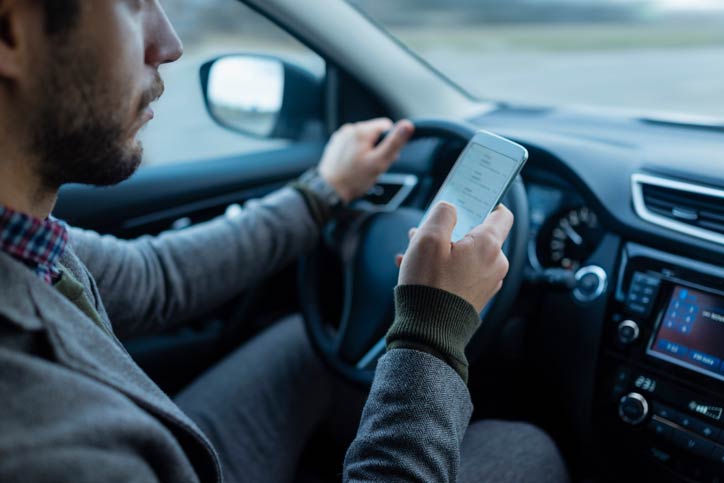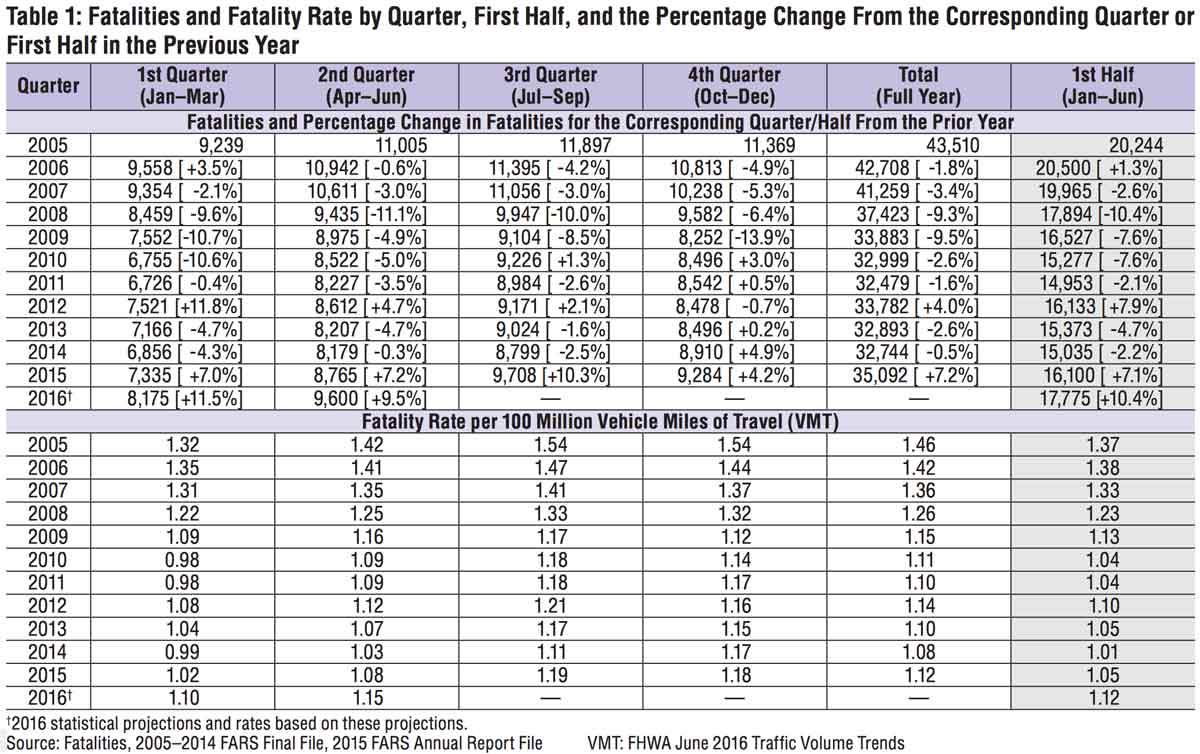
In Massachusetts, the law states drivers must pay attention in order to prevent injury to others. There is no prohibition on cell phone use while driving in New Hampshire. However, all New Hampshire drivers are prohibited from texting,
The National Highway Traffic Safety Administration (NHTSA) released the Early Estimate of Motor Vehicle Traffic Fatalities for the First Half (Jan–Jun) of 2016 in October 2016. The report indicated there was a 10.4% increase in fatalities over the same period last year (Table 1). Two things are alarming about this. Over the last four decades these fatalities have decreased.1 Secondly, this is the largest annual percentage increase jump in fatalities in 50 years.2
These alarming statistics lead the Department of Transportation in October to set a goal of ending fatalities on the nation’s roads within the next 30 years. The NHSTA, Federal Highway Administration, and Federal Motor Carrier Safety Administration are joining forces with the National Safety Council (NSC) to form with the Road to Zero coalition.4 Concurrent efforts will focus on overall system design, addressing infrastructure design, vehicle technology, enforcement and behavior safety. An important principle will be to find ways to ensure that inevitable human mistakes do not result in fatalities.
Although the NHTSA states, in reference to this report, that it is too soon to attribute contributing factors or potential implications of any changes in deaths on our roadways, other studies give some insight into one possible cause – distracted driving.
In December 2013 a report was prepared for Congress, Understanding the Effects of Distracted Driving and Developing Strategies to Reduce Resulting Deaths and Injuries5, that summarizes a series of studies undertaken by the NHTSA and others, to acquire the information needed to address the general problem of distracted driving, including distractions other than the use of personal wireless communications devices.
These distracting tasks affect drivers in different ways, and can be categorized into the following major types:
Visual distraction: Tasks that require the driver to look away from the roadway to visually obtain information;
Manual distraction: Tasks that require the driver to take a hand or hands off the steering wheel and manipulate an object or device;
Cognitive distraction: Tasks that are defined as the mental workload associated with a task that involves thinking about something other than the driving task
A national phone survey conducted by NHSTA in 2010 reported distracted driving attitudes and behaviors. It was noted that drivers under 25 years of age were 2-3 times more likely than older drivers to send text messages or emails while driving.
Among the behaviors that drivers reported doing on at least some trips:
- 80% talked to other passengers
- 66% adjusted the car radio
- 51% used a navigation system
- 46% ate or drank
- 41% made or accepted phone calls
- 30% used a portable music player with speakers
- 27% interacted with children in the back seat
- 26% used a smartphone for driving directions
- 22% changed CDs, DVDs, or tapes
- 10% read e-mail or text messages
- 6% did personal grooming
- 6% sent text messages or email
Auto Insurers Viewpoints
A recent study by True Motion of a half-million driver trips also found that when traffic slows due to congestion, many drivers pick up their smartphones to text or use apps.
Robert Gordon, senior vice president for the Property Casualty Insurers Association of America, said “Our auto insurance companies feel the biggest cause of the increasing accident frequency is this type of distracted driving”.6
Auto insurers have expressed renewed interest in what is known as usage-based insurance as consumers become more comfortable with sharing their data to get discounted rates, said Gwenn Bézard, co-founder and research director at financial services research firm Aite Group. FICO may be offering its Safe Driving Score to enter into telematics and help insurers provide usage-based auto insurance. By 2020, about 70 percent of all auto insurance policies in the U.S. will use telematics, according to estimates by Strategy Meets Action, a Boston-based research firm.7
U.S. regulators want phone makers to block most apps for drivers8
“With driver distraction one of the factors behind the rise of traffic fatalities, we are committed to working with the industry to ensure that mobile devices are designed to keep drivers’ eyes where they belong — on the road,” said NHTSA Administrator Mark Rosekind. The government says 3,477, or about 10 per cent, of the more than 35,000 traffic fatalities last year involved distracted drivers. That’s up 8.8 per cent over 2014.
The U.S. government unveiled voluntary guidelines in November, 2016 to reduce crashes, asking smartphone makers to lock out most apps when the phone is being used by someone driving a car.
Drivers could still make calls but the phones and automaker systems would lock out the ability to enter text. Internet browsing, video not related to driving, text from books, and photos also would be locked out. Navigation systems would be permitted, but with guidelines on how to avoid driver distraction.
Moving Forward on the Road to Zero Traffic Fatalities9
The short term strategies include improving useage of seat belts and motorcycle helmets; redesigning streets; truck safety; and leading driver behavioral change campaigns.
Long term, the efforts will focus on overall system design, new vehicle technology, enforcement, and behavioral safety. Automated vehicle technologies may make the goal achievable by the mid 2040’s.
Reaching zero fatalities will require commitment from the traveling public too. After all, 94 percent of crashes can be tied back to a human choice or error, like impaired driving, speeding, or texting behind the wheel.
In Summary
Traffic fatalities have increased at alarming rates in the last year. Distracted driving accounts for 10% of those fatalities, up 8.8% from 2014. Auto insurers feel the use of smartphone apps is the type of distracted driving causing these increases. The NHTSA unveiled guidelines in November 2016 that are the agency’s first recommendations specifically for portable devices that are used while driving, asking smartphone makers to lock out most apps when the phone is being used by someone driving a car. The Road to Zero coalition is working to reduce traffic fatalities to zero in 30 years, and state self-driving cars are an important component in achieving that goal.
While smartphone apps contribute to distracted driving and may be the cause of the recent increase in fatalities, it is too soon to attribute contributing factors or potential implications of any changes in deaths on our roadways. Regulators are not waiting for the definitive analysis, but are responding by taking quick action with guidelines and coalitions.
Sources:
1 National Highway Traffic Safety Administration (NHTSA). Early Estimate of Motor Vehicle Traffic Fatalities for the First Half (Jan–Jun) of 2016.
2 New York Times. Biggest Spike in Traffic Deaths in 50 Years? Blame Apps
3 NHTSA. Early Estimate of Motor Vehicle Traffic Fatalities for the First Half (Jan–Jun) of 2016; Table 1: Fatalities and Fatality Rate by Quarter, First Half, and the Percentage Change From the Corresponding Quarter or First Half in the Previous Year.
4 U.S. Department of Transportation. U.S. DOT, NATIONAL SAFETY COUNCIL LAUNCH ROAD TO ZERO COALITION TO END ROADWAY FATALITIES
6 Associated Press. Auto insurers: Distraction big factor in traffic death surge
7 CNBC. More auto insurers want to track your driving behavior in exchange for lower rates
8 U.S. regulators want phone makers to block most apps for drivers. Tom Krisher / The Associated Press. November 23, 2016
9 U.S. Department of Transportation. Moving Forward on the Road to Zero Traffic Fatalities Posted by U.S. Transportation Secretary Anthony Foxx and National Safety Council President Deborah Hersman

